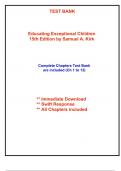Exam (elaborations)
Test Bank for Educating Exceptional Children, 15th Edition Kirk (All Chapters included)
- Course
- Institution
Complete Test Bank for Educating Exceptional Children, 15th Edition by Samuel A. Kirk, James J. Gallagher, Mary Ruth Coleman ; ISBN13: 9780357625231. (Full Chapters included Chapter 1 to 13)....1. Children and Youth with Exceptionalities and Their Families. 2. Children and Youth with Exceptionalit...
[Show more]



